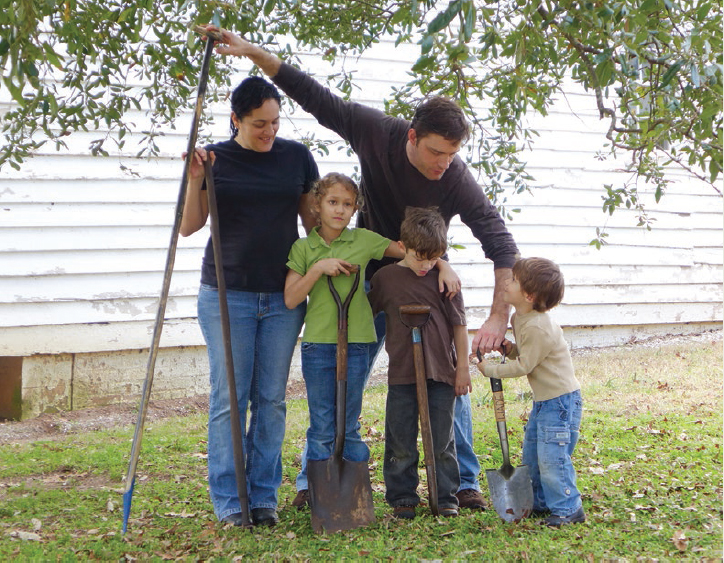
WHAT BECAME OF MACHETES? Once a very common household tool, people tend to laugh—the editor of this book, a gardener himself, laughed—when I talk about how machetes need resurrecting. Actually, he laughed when I said that I needed money to go to Haiti to further study machete skills, but he also admitted to not knowing how to use a machete. Hoes, mattocks, hand weeders, pocketknives, or dibbles elicit the same bemusement. How many people actually use any of these tools anymore? The golden age of hand tools peaked around 1930 and has been on a slow decline ever since. That has to change. Hand tools need advocates. They need us to keep them from falling into obscurity and rusting away buried in the mulch pile. We need them because they’re ingenious; they keep us in shape and connected to the ground.
Can’t you just feel it in your forearms—the satisfaction, the vibration of a hook blade knife, curling through the thatch, the lawn, into gritty dirt below? The satisfaction when you hear the little snap of tension when a dandelion root gives way to that sure blade? Can’t you relish the reward of a pile of weeds cut, cleaned, and taken care of, your gardening tasks done for the day? It’s just muscle and drive out there shaping our world. Or, rather, it used to be. Good tools and the skills to use them get forgotten when souped-up mowers or colorful bottles of chemicals seem so seductive. But like knives, forks, and spoons, simple garden tools have been perfected by the generations who depended on them. Solid, perfected, and sexy, hand tools work.
For safety and comfort, it’s important to use tools that fit your body. The Raintree family comes to visit and volunteer on our farm so frequently that we keep shovels made to fit each one of them.
For centuries, tools were made of wooden handles and metal implements. They were made at home or by local blacksmiths. They were made to fit individual needs; at the height of the Victorian gardening craze, for example, gardeners demanded hundreds of variations on hand hoes, cultivators, and sheers. But, basically, all hand tools are elaborations or modifications of spoons, forks, and knives. They were modified depending on your climate, crop, or gardening styles. For example, three-tined pitchforks were designed for moving light straw on midwestern farms, while five-tined forks work for longer hay in the South. Before factories, a good idea spread slowly, traveling by word of mouth and example from blacksmith to blacksmith. The early 1900s, with the Industrial Revolution, brought uniformity and the availability of hand tools. We had new factories that made variations on tools to custom fit every weeding need, every size row, and even every person’s height and weight. With industrialization came mass production and suddenly a great idea from some old Victorian greenhouse gardener was available in stores around the world. The best blades from Caribbean sugarcane fields, tools never seen elsewhere, could now be shipped and shared. Hence, we had fleets of things like wheel hoes—remember wheel hoes? Those lightweight, wooden-handled, push plows with a big metal wheel up front and interchangeable blades at your feet? My father used one until the 1980s and, in fact, there are a few New England companies still making them. We had customizable rakes and Amish digging forks in every hardware store in the United States. Most importantly, we had diverse farms and gardens full of people who would actually get out there and put those things in the ground. Even the words for different kinds of tools became more uniform. Think of lots of little village blacksmiths making some combination of shovel and axe. One might have called it a mattock, one a handpick, and one an adze, but eventually we all started to call those things hoes.
Alfredo has worn the handle off of his machete and replaced it with a washcloth and duct tape.

My friend Alfredo helped me hone my machete skills on his family coffee farm not too far from the border between Haiti and Dominican Republic.
But the changes in tools in the early 1900s paled in comparison to the seismic changes brought on by World War II, which introduced and left us with the small motor. This changed everything—even how we pick up leaves. Before the war, there was indeed small motor technology, and a typical, prosperous farm of the time might have had one single engine. But it was a big, immobile thing. The motor stayed in one place and the farmer brought different attachments to it—for example, a corn sheller, butter churn, saw blade, or a pump. But during World War II, for the settling, moving, feeding, cleaning, and draining land for thousands of men in the Pacific, the government needed the industry to better develop and to downsize the motors. As a result of this pressure, motors not only improved, but after the war, we were left with small motor factories that needed a shift in purpose. And millions of people who’d fought in the war and seen these things save time, human energy, and lives came home to make their world better. My grandfather was the first man in Hampton County, South Carolina, to have motorized equipment, and he was so in demand, he never even had time to farm his own land. Farmers who still had hoes and mules hired him and his motors to work their fields. But this was never going to be enough to sustain these motor-making factories, and the country was gradually leaving the farm, anyway. What else can we make? How about putting motors on those old blades and shovels and selling lawn mowers, edgers, or tillers to the new suburbanites? Briggs & Stratton, for one, developed the first lightweight aluminum engines, and the suburban gardening revolution began.
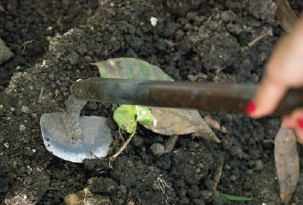
The perfect accessory. This well-made tool has been passed down through generations. It started life as a full-size hoe that belonged to a friend’s grandmother. Over the years, it’s changed into a hand hoe imbibed with memories.
We’ve all seen how eager new homeowners have embraced these seductive new technologies. I think it’s their seeming complexity that drew us in. Hand tools began to feel like antiquated accessories. Motorization made the new things seem more professional, too, more awesome and sophisticated. So we forgot the old farm tools, and they soon turned into termite dust and rusty dull hooks. All the while, people who could carve hickory handles and sharpen machetes left us, too. Without those skills, hand tools got stashed in the barn with the old butter churn. We motorized machetes, swing blades, trenching and edging shovels, clippers, brooms, and, most absurdly of all, wheelbarrows.
What didn’t get a motorized replacement got a pump and a magic tonic. Sprayers took the place of weeding knives and even tarps—yes, tarps. You can actually buy liquid glue that you mix up in a hose-end sprayer and then squirt on piles of leaves to glue them all together so the wind doesn’t mess up your pile. It’s basically a tarp in a bottle. Is it just me or does that make you want to lift one of those hair-sprayed leaf piles and put it on your head like a giant, multicolored, maple leaf, beehive headdress?
We sure love to spray things—I’m sure there’s a text somewhere on the evolutionary reasons that spraying seems so satisfying, so fun. The idea of liquid tools is so compelling that there are miles of racks of them in stores; it’s a huge industry. We can’t take our eyes off bottles long enough to find that hook blade knife and gouge seven weeds from the dirt or squish three worms on the cabbage. There’s even a hand-held garden sprayer with a rechargeable battery-powered pump attached. How did we get here?
The truth is, I’d like to be able to say that hand tools are simple, but they do require skill and training. Maybe that’s another reason for their demise: we’ve simply forgotten how to use them. They look so simple, a wooden handle with a metal blade. But wood and metal can hurt. I have a knee scar from machete training and plenty of dents on my fingers from newly sharpened shears. Sometimes we can’t even figure out what some old tools were used for—we’ve drifted that far. Hand tools have their complications. But they better connect us to the ground, to craftsmanship, and, today, to a generation of ingenious people who worked hard and appreciated elegantly effective tools and the satisfaction of honed skills.
The Teachers
GARY AND JENNIE WHYNAUCHT AND BOB DENMAN
There’s something about midwesterners and their fascination with old tools. There’s probably an ethnography of them and their tool fetish on some bookshelf, too. Though lots of my old mentors still use hand tools to garden, the teachers in this chapter represent more: a history with and an updated love for old hand tools. Gary and Jennie Whynaucht and Bob Denman are part of the diaspora of the Midwest who share and teach their love of tools.
Gary and Jennie Whynaucht are midwesterners who settled in North Augusta, South Carolina. They and my parents met and shared their love for old things, for soup, history, and tools. Gary is a Michigan man with grit and a quiet respect for your personal space and privacy that wears off in minutes, and soon he’s telling you every detail of the past, present, and future uses of this amazing sprinkler that he found at the 400-mile yard sale in Kentucky. He left Michigan to be a Navy machinist and settled in a little town near the Savannah River with his wife, Jennie, who’s from Illinois and Wisconsin.
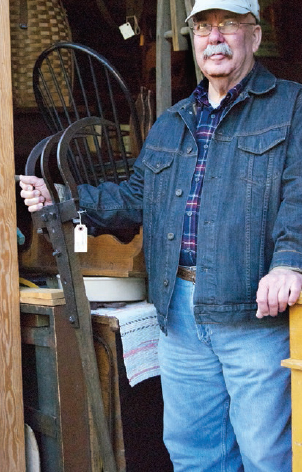
Gary Whynaucht with a mysterious, hefty rake made from old plow parts and the hinge from a barn door.
The wide river keeps things humid here. Spanish moss drapes a crepe myrtle tree. Old tables, a woven tobacco drying rack, and a canoe hang on the barn, which looks like an old tractor shed. Being there, you want to explore, to scavenge, and to touch rusting treasures, and you can. Gary and Jennie run a unique hybrid of junkyard and antique shop. Step into that little barn and get lost among the junk; then if you make it out, there’s a metal building, Gary’s one-man factory, with piles of old shovels, model planes, and sprinklers. This serves as the supply line for the charming antique store they run out of their little Victorian cottage.
Gary fixes stuff, including old garden tools, and Jennie sells stuff, though Gary is quite the salesman himself: “I sell those old sprinklers for people to put on their patios just like misters you see now at amusement parks. I tell people, just hook them up and turn them on—let the water droplets cool the air. You’d be amazed at what I can sell.” Gary and Jennie not only sell from their shop but, literally, all over the country, setting up booths at garden shows, tractor pulls, and sometimes antique shows. They’re always looking into other shops for objects, parts, and ideas, so they know antique farm and garden tools from all over the country.
When you meet Gary and Jennie, you know they’ve built this whole place themselves. Gary’s a fix-it guy, an engineer. You can see the layers of his interest: gardening tools, piled on sprinklers, piled on industrial gears and chains, all on top of a couple of old Volkswagen Beetle engine blocks. He can fix those, too.
They first met my parents while driving around looking at old places, old barns, and meeting country people. Jennie reminds me, “We loved being with your parents. We’d get together on Sunday nights for a bowl of soup. We always took something we’d stumbled onto, and Gus would explain southernisms.” They all loved to snoop around the countryside, then sit around the kitchen table and marvel at the ways people adapt and change.
In plundering his shop recently, I found some of Gary’s meticulously dismantled, cleaned, oiled, and renovated pitchforks. Some are being restored to their original condition. He also has lots of homemade hybrids—things people made from parts of other things. He shows me his renovation process: how to release old rusty parts with a little heat from a torch, how to wire-brush them without taking off all the original color, and how to shine them up with a little lacquer. He was working on a cultivator rake with removable 10-inch, curved, hard tines, each attached with bolts. The bolts allow you to adjust the rake to fit between different size rows or to replace a broken tine; this one is being returned to its original condition.
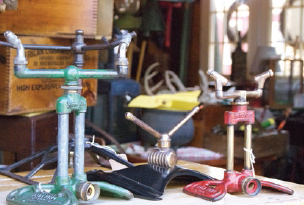
Antique sprinklers represent the taste of different eras.
This shop is like a salvage yard. Its inventory of broken handles, blades, rake parts, and boxes of old sprinklers wait to be joined by the next new finds. When Gary finds something special at a yard sale, something missing a part, he knows just where to look in his own shop for that part. He can renovate or update from his shop. Since lots of their customers are buying sentiment, memories, and romance—even art—Gary amends for that market. Sometimes, he makes things pretty: he’ll take a broken handle from a shovel, made of beautiful wood, with a burnt-on insignia, and he’ll hone it down into a dibble. Or a hoe, with edges beyond repair, will become a whimsical heart-shaped hoe, perfect to display on your porch or mounted by the front door as a coat rack.
Gary picks up a curved, hard-toothed rake made from old plow parts and a hinge from an old barn door. The thing weighs about 15 pounds. We marvel at the adaptation and the muscular customer who requested it. It makes us want to know more, to contemplate the need and the story that brought this crazy, heavy, rigged-up thing into being. We’re both curious about the rake’s history, the lost creation story of this behemoth. I’m curious about how hand tools differ by region. Do you find more homemade, rigged things in places that used to be poor? Did termites or weather or labor issues influence the styles of tools in Minnesota versus Texas? Where are people today most into collecting and using old hand tools? Though that’s a question that Jennie and Gary can quite confidently answer: “the Midwest.”
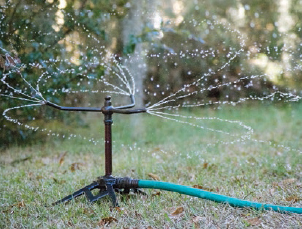
Sprinklers in action make for artful watering and cooling tools.
They speculate that in the Midwest, the climate dictates that tools get put up at the end of the summer. Often, tools, wheelbarrows, and such were put into the granary, literally covered with grain, then not used until the next spring as the grain reserves drop to reveal the tools. In the South, the climate means that tools are left out all winter, subject to rot and wear. Other possibilities include the cultural history of farming in different regions. Midwestern small farmers tended to do everything themselves, so they knew, cared for, and stored their own tools. Easterners, however, tended to have access to more temporary labor, so people there may not have put as much effort into tool care.
Some of this history is just fun speculation. We like to imagine stories of people who might have needed, used, and adapted certain tools. Bob Denman, on the other hand, wants the facts. Bob is a former journalist who set out on a project to compile a complete history of hand tools. Bob ultimately became a blacksmith in Oregon, an authority on the history of old tools and a seller of more hand tools than you can shake a hoe handle at. Bob makes new tools, with old methods. I use his tools in my work, and I treasure them.
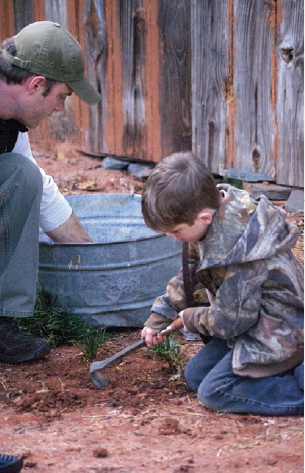
My favorite hand hoe, made by Bob in his Red Pig Tools shop, gets used constantly. Joel Raintree and his son Reid use it to make divots in hard clay for planting small grasses.
One of the first things Bob said to me from his home in Boring, Oregon, was, “I lived in South Carolina for two months. Camp Jackson just before I shipped out for Vietnam.” I’ve heard this before from veterans; they always go on to say how South Carolina was hotter than Asia, and they haven’t been back to either place since. I thank them for their service and tell them that South Carolina is still the hottest place in the South. Bob might have escaped the heat of the South, but now he’s a blacksmith, just about one of the hottest jobs a person can choose. Bob’s nighttime hobby became a gardener’s treasure chest: his business, Red Pig Tools, produces about 250 different tools, and he knows more about the history, manufacturing, and uses of hand tools than anybody else in the country.
He wasn’t always a tool guy, but there was an old man in his life who wanted to pass on the craft of blacksmithing. That mentor saw in Bob a spark of creativity and an interest in working in front of a forge fire. So with a full-time job, Bob smithed at night. He says the basic skills were easy, but the art, the certain twists, curves, and angles that make a tool perfect, took years of practice. And while the tools as objects occupied his hands, the tools as history occupied his mind to the point of obsession. And his training as a journalist meant that he knew how to follow a good story and research minutia. He’s still perfecting his craft—he’s also doing his part to pass it down, as well. While we were talking, Bob’s new apprentice, a young man who shares that same spark, came in with a still-hot Swedish-style brush axe; Bob is blown away by the artfulness of the work. Then he launches into a history of Swedish-style brush axes and their replaceable blades. The history of hand tools makes for good storytelling, and those stories are getting passed on more and more as modern gardeners seek quality tools.
Bob can launch into the history of just about any tool you put in front of him. And he can explain what to look for in a good axe, hoe, hand claw, shovel, or asparagus-harvesting knife. He’ll start with a seemingly random story, like how the half-moon edger was originally made by Roman soldiers to cut turf to build walls and ramparts. Through stories, he explains the history of metals and how the best wooden handles still come from Appalachia. Bob tells me that in the heyday of hand tools, you could go into any hardware store and find a broad range of tools to fit your exact need and even your body size. There were more head shapes and many shapes came in different widths. Each width was available in several handle lengths. In Bob’s shop, this is all still the case; he often customizes tools by modifying blade width, height, or pitch and by modifying handle length.
• Metal. Mild, forged steel is best. It’s hard enough to be sharpened and hold an edge, but not so hard as to be brittle. Cheap, soft metal can sometimes be bent or nicked simply by pressing it against a concrete floor. Metal parts should be forged, made as one piece, or if there are attachments, one piece should penetrate the other.
• Wood. Look for a “Made in the USA” sticker. Great handles still come from hickory and ash forest surrounding the Appalachian Mountains. Good wood will have a dense grain, like an old baseball bat. One simple trick for learning what brittle wood looks like is to find a cheap broom and examine the handle. Many cheap broom handles are made from the tropical tree, ramin. It’s fine for brooms and towel racks, but it breaks under stress—and the tree is considered endangered. If a tool’s handle looks like a broom handle, keep looking.
• Metal and wood connections. Take a look at how the metal blade is attached to the curved metal part. If you see a little glob of molten metal, that means the blade is “tacked” on and will easily break off. The collar that holds the blade to the wood is called the ferrule. Its purpose is to protect the handle from cracking. Flimsy plastic or metal won’t do the trick. Look up into the ferrule. A strong connection is a squared metal blade “stem” pushed into a round hole in the wooden handle. The best tools have a small, ratchet-like collar adding strength, but you can rarely see it. Look for a rivet or small rod punched into the handle, piercing the ferrule and the wood.
The most efficient hand pruners are angled to line the cutting blade up with your forearm.
Bob can put into words preferences I’ve developed for tools but never really thought about. He explains the reasons behind some of my tool preferences. For example, as a guy with decent biceps, I like a heavy tool. The heft adds cutting and digging strength when I work. I know some people prefer lightweight aluminum for shovels and hand tools. I ask Bob if he works with any materials besides steel and wood. But no, he stresses, the word blacksmith specifically refers to the black oxides that come from iron or steel. “Anyway,” he explains, “aluminum is too soft to hold an edge.” It makes a fine shovel or hand claw if you have good dirt, but I often work in rocky, rooty soil, so a sharp steel spade is my preference. Since I’m always breaking tools, I want tools that can be repaired, and neither aluminum nor fiberglass can be fixed. Inevitably, my tools will be run over or snapped off when I try to use a shovel to pry up a 300-pound crinum clump. I can still hear my daddy yelling at me, “Boy that shovel is not a pry bar. If you need a pry bar, go get one. Don’t break my good shovel.” Alas, old habits die hard, and I still use shovels to pry, so I need shovels that can be repaired.
Another trait of my tools that Bob asked me to consider is their weight and balance, especially when choosing a mattock or any hand tool that might put stress on my wrist. A mattock with a hollow metal handle is just too light to actually move dirt. It bounces if it hits a stone, stressing my wrist. After his questions, I realize that most of my tools are the same as his: wood and steel. In fact, many of Bob’s tools are replicas and adaptations honed by professional gardeners. He finds old tools in garden shops and books. Some were even mass manufactured at one time. So he’s following the lead of tools perfected by gardeners over centuries.
He also considers all sizes of people and even keeps abreast of ergonomic research. When I asked him for advice about my hand pruners, he told me that while mine were quite good, he recommended another brand because they’ve modified the tilt of the blades according to military studies on hand movement. Taking his recommendation, I now use Bahco ERGO pruners and have less cracking in my wrist after a long pruning session.

The author and his niece, Caroline, with donkeys Buck and Justina, who keep the pastures mown and provide manure for compost. But they’re not the only tools shown here: red and yellow clover in the pasture work to produce nitrogen.
Choosing high-quality and thoroughly tested hand tools is essential for people like me, who use them a lot. It makes your work faster, easier, and just better. I work with a woman who hates my shovels; she swears by her lady’s ergo shovel. Bob reminds me that tool quality and choice can seriously affect your body. He’s great at editing tools and helping people find just the right tool for the job and for their body. The most important step in choosing tools is finding tools that make the work smooth and safe for you. As Bob said earlier, find the right shovel, rake, or hoe height; find the right balance and weight for your body; and keep things sharp and clean.
Gary and Jennie and Bob represent the romance and the practicalities of choosing and using tools. For me, and for you, those are important choices. Tools can connect us to history and old memories and keep our bodies in shape for another day’s gardening.
Updates and Adaptations
My tool chest, full of old wooden and metal tools, looks pretty old fashioned next to the mobile mechanic shops of many other landscape professionals. I can find some of my tools in kitchen stores, while others are bought on trips to places where people still make tools by hand. However, I still use the occasional motor, and there are plenty of plastic handles, sprayers, pumps, and a sleek German knife or two. One of my favorite modern tools is not a variation on knives, forks, or spoons—it’s more like a crescent wrench. I even have living tools: yes, Buck and Justina, dwarf donkeys, mow the pastures, saving us hundreds of dollars a year in diesel for the tractor and bush hog. And if you consider that one of the overarching tenets of this book is that gardening itself is caring for the earth, then microbes, worms, bees, and plants are tools, too.
In our landscaping work and in our crinum nursery, Tom and I have very few motorized tools. We keep our blades filed, oiled, and handsome—or at least we try. We run a gardening business and a farm in a climate where there is no long resting season. So our tools wear out fast and repairs are often a low priority considering everything else we have to do. Nonetheless, it works for our nursery and garden design business, and it works for our home garden. It really is possible; you really can garden without an air-polluting, cough-inducing, gas-powered blower or mower.
One little blade that I wouldn’t be without is my hook blade pocketknife. It’s nothing complicated, just a single blade in a plastic case, but the hook is the key. With it, I can get a weed from between perennial crowns, divide a grass into twenty little bits to spread around, and weed a lawn in a way that is satisfyingly addictive. I use a blade made of hard Swiss metal. When I’m using it in the grit surrounding little bulbs, it dulls quickly—I’ve sharpened these down, over years of use, to thin vestiges of their former selves. They’re cheap enough that when lost, given away, or sharpened into obscurity, I just get a new one.
But the blade that draws the most questioning glances when I use it is the machete. Its uses are almost endless: cutting stakes, shearing hedges, chopping mulch and green stuff for the compost, limbing trees and brush, clearing a path through an exuberant perennial border, leveling overgrown cannas, shearing pansies, splitting bamboo, and building upper body strength and stretching. You can even do a little light mowing with a machete, leveling annoying bahia seed heads or dandelion flowers that pop up overnight. When I first started really watching people use machetes, on a tiny coffee farm in the cloud forest of the Dominican Republic, I quickly started to wonder why we didn’t use them back home.
One evening, sitting around without power but with plenty of rum and thoughts (the kind of thing you do in remote villages where nights are long and dreamy), I remembered that my daddy knew how to use one, and I tried to unravel how he might have learned. Could daddy have learned in Cuba, where he was a US Navy Seabee doing ground-floor construction for Guantanamo Bay? Or maybe he picked it up in Spain or Africa? I tried to recall his stories. Then, in writing this all down, it dawned on me that he grew up making molasses from sugarcane and a mule-driven screw press. The process depends on cleaning leaves from the cane, which was all done with machetes. I’ve seen boys in the tropics doing this, wearing nothing but shorts. As luck would have it, back home I was able to dig out some old pictures of daddy and his grandmother by the molasses press, blades cleaned, cane waiting to get squeezed. Later, Gary Whynaucht showed me the folding pocket machetes that lots of American soldiers learned to use. In other words, Americans did know how to use machetes. Not only did most of us not only forgot the skills over the years, but we forgot that the tool was even a part of our parents’ toolbox.
These hedges are well kept with a combination of gas-powered sheers and hand pruning. My bench design for this garden was inspired by another tool: lobster traps seen in Maine.
For shearing, however, machines do work well, and some of my favorite motorized tools are my electric and gas hedge shears. I’m not into tight, crew-cut hedges; they’re just too much work in the South. But for my tall bamboo hedge, for perennials and annuals, and of course for giant expanses, motorized sheers do the trick. People tend to freak out a little when they see me do this, but I love to shear pansies and perennial borders. It’s not a control thing—well, it’s not too much of a control thing—it’s just an understanding of plant growth and responses in our climate. Pansies stretch here; when we plant in the fall, it’s often too warm for them, so they stretch and look floppy. To remedy this, I shear them so they’ll be tight in the winter. If I have only a few, hand pruners do the work. But if I have flats to plant, the electric hedge shears or a very fast, sure swipe of a machete behead the little, floppy plants cleanly. After this, they’ll produce more side shoots, and hence more flowers. This was a lesson that Ruth Knopf taught me: for the most bountiful, colorful, carpet of spring pansy flowers, sacrifice the piddly winter flowers and pinch until March, which is easy in a small garden. In a mass, a quick shearing produces waves of spring flowers.
In our crinum nursery, we have two mechanized blades: a tractor with a bush hog, for mowing fields, and an old DR mower that we call the push hog. Both are for brush cutting, for work that could only be done otherwise by an entire crew of people. Both are over twenty years old—quality matters. The DR mower does allow me to grow things like Vinca major and Indocalymus, aggressive groundcovers that need a severe cut back every few years. Yes, a sling blade could do the same thing, but as with hedges, we make the call that the labor needed for that is more than we can afford, and as long as we keep their usage to once a year, the environmental cost of the smelly mowers won’t be too heavy.
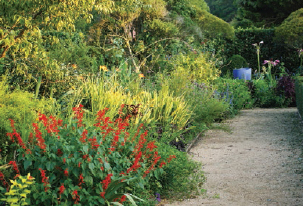
I planted and kept this formal perennial border for ten years. With our long, hot summers in South Carolina, we can sheer many perennials a few times a year.
As I mentioned earlier, we also rely on hook blade knives (sometimes called grafting knives). For dividing crinum, the power of water, to wash away soil, and a good hook blade do the trick. I love working with knives; I think back fondly on learning to sharpen them with my father with whetstones and files—kind of like learning to shave, a mystery shared between father and child. We also use a large, underappreciated tool called a Weed Wrench (available from www.weedwrench.com), which is kind of like a giant pair of pliers on the end of a balanced lever. It is used to pull up tree seedlings and saplings by uprooting them. As crinum are a long-term crop, most of ours stay in the ground three years before they are ready to sell; we get pecan, hackberry, mock orange, and other tree seedlings as weeds. The lever grabs a seedling at ground level and when you lean back on it, the seedling will pop out of the ground, from around the mass of perennials, with every little bit of its roots intact.
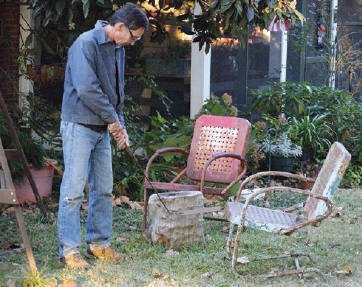
Tom with a slender sling blade. Sling blades, swing blades, and scythes need to be incorporated into all modern tool sheds.
Our crinum fields are edged by pecan trees, and, in some places, even underneath them. Crinum thrives in light shade, but as with any shade garden, you have to keep the canopy thinned. So we have two tools for that: loppers on a pole and a fantastically sharp pruning saw. The loppers can be sharpened, but a good saw has a replaceable blade. I buy mine from a local dealer, because I know they’ll always have the right replacement parts. I once splurged and bought myself a Japanese hand saw, only to realize that our saws cut when you pull back on them while Japanese saws cut when you push (a little secret of effective sawing is to understand that most saws only cut on the pull back stoke; the forward stroke is only to get the blade back in place. Knowing that saves lots of energy and wear on your forearm). Make sure you know what you are getting.
We also have an array of carts and wagons. As with any tool, quality counts. We still use an American-made wooden garden cart that’s about thirty years old. The plywood has been replaced twice. For all our carts and wheelbarrows, we use only solid rubber tires so as to eliminate the frustration of flat tires and having to change the tubes.
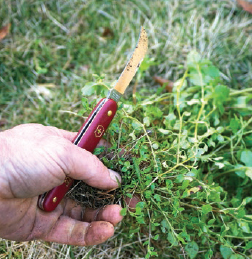
There is nothing as rewarding as getting an entire, sprawling chickweed out with one simple slice through the stem. My favorite tool for this is a simple and inexpensive hook blade (or grafting) knife.
Almost all of our farm tools go on the occasional road trip to my clients’ homes—I rarely feel the need to add new things to my array. Many clients do have their own mowers and other tools like that, and usually they have other people who do that work for them. I just do the gardening. People tend to get a kick out of some of the simple farm tools that I cart over from our farm, which work great for suburban-size landscapes. One of these is a chest-mount spreader that I use to spread cover crop seeds or fertilizers. Mine allows for even applications and even directional spreading. I’ve had the same one for fifteen years. Another simple tool that people like to see in action is our compost tea maker, which I described in chapter 2. I start the drum one day, turn on the aerators, and use the tea the next day to inoculate soil with microorganisms. The simple submersible pump brews the tea; then turned around, it becomes the applicator.
My machete collection stored on the side of the crinum shed.
Three of our favorite, well-worn carts: a double-wheeled wheelbarrow with solid rubber tires (right), an American-made garden cart that you can repair with plywood (left), and a wagon-like cart made by my daddy, who used the wheels from his father’s cart to build it.
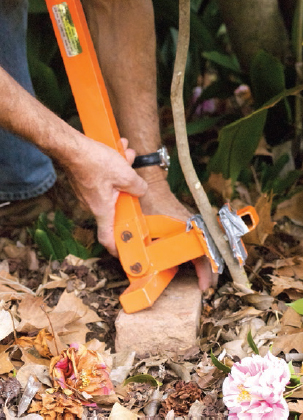
My Weed Wrench is great for uprooting weed tree seedlings and saplings. This is the smallest size you can get.
All the tools I use connect me through history and biology to caring for the soil, to memories of people who used them before me, who shared and passed on these simple, effective, common-sense tools and skills. It’s time for us to do our part, too. Whether you are a gardener or just hiring one, help bring back the romance and the exercise and the attention to detail that comes from using good old muscle-powered hand tools.
And since all those notes need a place to go, I turn to a computer program called FileMaker. My friend and mentor J. C. Raulston introduced me to this program over twenty years ago, and I’ve relied on it ever since. Easy to customize and easy to share, this true database stores decades of names, notes, photos, and articles. I’ve built simple, journal-like databases for many of my clients so that they can better manage their plants. And in every botanical garden I’ve worked on since J. C.’s intervention, I’ve insisted on the implementation of customized databases to fit the project’s needs.
My partner in all of this today is Hunter Desportes, who helps me make sure that the databases better fit each client’s needs. During his work, Hunter asks key questions about how each database will be used, and how the separate fields and elements relate. In our botanical garden work, we chose this system to manage huge plant collections because it’s powerful and user friendly. It helps develop plant management systems to document, inventory, and produce work reports, labels, and publicity for the plant collection. That’s never an easy task for me, but getting it right from the start means that all those notes, photos, and flowering dates can be combined into a large and useful record. Today, I can stand in my crinum field, in the dead of winter, all plants dormant, and look at the database on my phone to know where any one plant is and dig a custom order. For a garden client, we can look through the database to produce a quick report, with photos and plant names of garden work that needs to be done each week. A recorder, a camera, and a database are like the quill, sketch, and ledger of modern gardens.
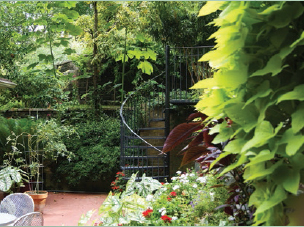
In this multilevel garden, hand tools are a must, as most mechanized tools simply don’t fit. The owner of this garden also keeps his work list, pictures, and notes in a database.